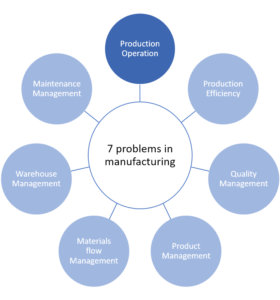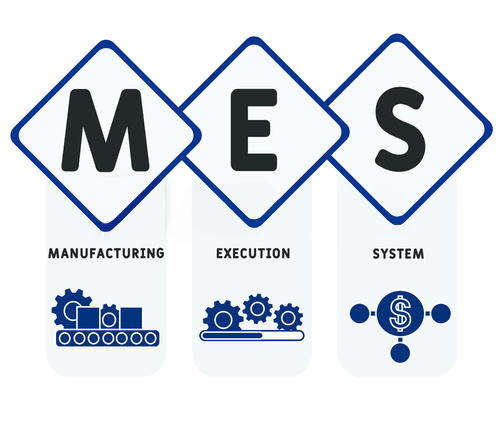In the context of globalization and the continuous development of technology, the manufacturing industry is facing increasing challenges, requiring businesses to continuously innovate and improve to maintain a competitive advantage. Application of manufacturing operating system (MES) is one of the important solutions, not only supporting production management but also a key factor in building smart factories and promoting digital transformation. This article will address the challenges of modern manufacturing operations and the important role of MES systems in solving them.
Objectives and problems in production operations
In an increasingly competitive environment, efficient production operations are vital. To achieve this, businesses must commit to implementing the 4Rs of production: Right Quality, Right Quantity, Right Timing, and Right Fulfillment.
However, achieving the 4D goals is not easy. Manufacturing enterprises face many problems in production management, requiring effective solutions.

Among the above issues, production operation is always the top concern. We will analyze this issue in more detail in the next section.
Challenges in production operation
Managing production operation effectively always comes with significant challenges. For convenience, we will divide these challenges into three main groups:
Group 1: Comprehensive perspective on production operations
Comprehensive information plays a key role in helping businesses grasp the overall picture of production operations. Challenges can range from a lack of information such as:
Order status
Manual and fragmented management prevents information from being updated promptly and accurately. As a result, businesses have difficulty optimizing production processes and delivering goods on time, affecting reputation and customer satisfaction. In the long run, this lack of information makes it difficult to forecast and plan production. This leads to waste of resources and reduced business efficiency.
Details about each step of the order.
Detailed information about each step, such as who is doing it, which machine is doing it, in which workshop, etc. is not recorded in real time but is only on the established plan. Therefore, this lack of detailed information makes it difficult to determine responsibility when an incident occurs, and makes it difficult to properly assess the actual situation compared to the plan. This makes it difficult to analyze and evaluate to improve the production process.
What raw materials are being consumed?
Manual recording in books or Excel, not synchronized with warehouse management systems, causes information about used materials to not be updated in a timely manner. Therefore, businesses cannot accurately grasp the actual quantity of raw materials in inventory. This leads to large temporary inventories of products, making it difficult to optimize inventory management and affecting production efficiency.
Condition of machinery and equipment
Monitoring the status of machinery and equipment currently still has to be done by directly contacting the workshop director or checking each machine on-site. Therefore, it takes a lot of time for businesses to make production management decisions and also make decisions to receive new orders. Thereby affecting the competitiveness of the business compared to other competitors.
Group 2: Interaction with production
Interaction with production is the connection between information on the management system and actual activities at the factory. This lack of connection causes businesses to face many challenges in capturing information about:
Production process
The failure to capture information about the actual production process originates from the fact that the management system is not connected to real-time production activities, leading to inaccurate and untimely information. Therefore, businesses have difficulty controlling progress, detecting deviations and making timely adjustments. Furthermore, not capturing information about the production process also affects the ability to forecast and plan production, leading to waste of resources and reduced business efficiency.
The machine settings correspond to the production order
Currently, systems such as CAM/CAD operate independently and loading, installing, and downloading programs for machines to execute production orders is still managed manually. Therefore, this manual management leads to a situation where there are too many drawings and difficulty in retrieving them when necessary. Furthermore, this also makes it difficult to control and ensure machine settings comply with production orders. The consequence is that production does not meet customer requirements, affecting the reputation of the business. Producing products that do not meet customer requirements not only affects the reputation of the business, but can also lead to additional costs such as repair costs, product rework costs, and even loss of customers.
Performance of lines and machines
Monitoring the performance of lines and machines at many businesses today is still done manually with paperwork, because the SCADA monitoring system is not synchronized. Therefore, this manual performance recording can easily lead to errors and missing data. Furthermore, this also makes it difficult to accurately assess production efficiency, but also affects the decision-making analysis results of machine learning (AI) models.
Worker-resource performance
Current worker performance monitoring mainly relies on year-end evaluation sessions, causing the information collected to not fully and promptly reflect the actual capabilities of workers. This makes it difficult to accurately assess productivity and work efficiency, leading to waste of resources or local labor shortages due to the inability to optimally allocate and coordinate personnel. Furthermore, the lack of detailed performance data also limits the ability to analyze and improve work processes, thereby affecting the overall productivity of the business.
Group 3: production optimization
To optimize production, businesses need to solve the following problems:
Optimize production arrangements – The problem of optimizing production arrangements aims to minimize waiting time, increase productivity and efficient use of resources.
Responding to changing needs – Businesses need to be able to respond quickly and flexibly to changes in market demand.
Predicting production quality – Predicting product quality helps businesses proactively control and reduce waste.
OEE/OLE/OPE Improvement – Improving OEE/OLE/OPE indicators is an important goal to improve overall production efficiency.
Minimize waste and waste – Minimizing waste, wastage and saving energy are key factors to reduce production costs and protect the environment.
Lean manufacturing (LEAN)- Lean manufacturing (LEAN) helps businesses optimize processes, eliminate waste and improve competitiveness.
However, due to the challenge of lacking comprehensive information, businesses have difficulty self-assessing and analyzing strengths and weaknesses to come up with appropriate improvement strategies. Solving these challenges requires businesses to have an overview and comprehensive view of production activities, and apply advanced technology solutions such as MES systems to optimize processes and improve production efficiency.
What is the MES system?
The MES system (Manufacturing Execution System) is a comprehensive solution for manufacturing plants, a collection of specialized applications, operating in harmony on a single platform. MES monitors and controls all production activities, helping businesses improve productivity, reduce waste, ensure quality, optimize processes and make wise business decisions
MES system functions
To help businesses achieve the mentioned goals, MES systems provide typical functions such as
Manage production moderation
This function provides an overview of order status by collecting information from production orders, detailing each step, and allowing the production department to update actual progress. Thanks to that, businesses can capture detailed information about orders, each stage, raw materials in use and production status. Based on this information, businesses can compare actual progress with the proposed plan, evaluate and analyze. From there, it is possible to detect arising problems early and take timely corrective measures, ensuring on-time delivery and improving production efficiency.
Resource management
This function supports businesses in making quick and effective decisions in production operations, as well as in receiving orders from customers. MES systems can provide detailed reports on the performance of each machine and each production line, helping businesses identify bottlenecks and come up with improvement measures. In addition, the MES system can also manage machinery maintenance history, helping businesses plan preventative maintenance to minimize machinery downtime.
Plan production
The mes system helps Ensuring high detail and accuracy in the planning process. Instead of just stopping at the general management level, MES performs detailed allocation of resources, from raw materials to work for each stage of production. Thanks to that, production plans are always updated and consistent with the actual situation, ensuring products are delivered on time and meet customer requirements.
Monitor real-time production operations
With event recording capabilities, MES displays all production activities in real time. Thanks to this, MES provides real-time reports on production status. At the same time, the system sends warnings about machine downtime and labor problems. Thanks to that, the production department is always updated with the latest information about the production situation.
In addition to the mentioned functions, the MES system can also be customized to meet the specific needs of each business, depending on the industry and production sector. With high customization capabilities, the MES system can be flexibly adjusted to suit the production process, management requirements and business goals of each business.
The role of MES in production management
The MES system with superior functions plays an important role in providing a comprehensive view of production activities for businesses. To optimize the interaction between the management layer and the production execution layer, the MES system needs to be integrated with other systems. In the context of modern manufacturing, to help businesses solve production management problems, the implementation and monitoring role of the MES system when linked to the production and management layers is shown as follows:
Link to production floor
When linked to the production floor, the MES system becomes a comprehensive manufacturing data platform, providing transparent real-time information. Thanks to that, each department can access the same information source, minimizing duplication and data discrepancies. From there, departments can coordinate smoothly to ensure efficient production activities.
Link to the administration layer
When linked to the management layer, the MES system acts as an information bridge, helping businesses operate smoothly and seamlessly, thereby bringing the following benefits:
- Improve cost structure: MES helps businesses identify costs incurred during the production process, thereby providing effective cost-cutting measures.
- Increase production efficiency: MES helps businesses optimize production processes, minimize downtime and increase productivity.
- Operational asset management: MES helps businesses monitor the status and performance of machinery and equipment, thereby planning timely maintenance, repair and replacement.
- Promote compliance: MES helps businesses comply with industry regulations and standards, ensuring product quality and labor safety.
- Provide real-time and accurate information to managers: MES collects and synthesizes data from many different sources, providing managers with a detailed overview of production operations, helping them make data-based decisions.
- Support planning and forecasting: Data from MES can be used for production planning, demand forecasting, and resource optimization.
Improve control and decision making: MES provides powerful analytics and reporting tools that help managers track performance, identify problems, and make timely corrective decisions.
Summary
Hopefully this article has helped you better understand the challenges of production operations and the role of MES systems in modern manufacturing. Starting from our commitment to 4D in production, we have identified 7 hindering issues, of which the issue of production management is the most important. Next, we analyzed these problems to understand their causes and consequences. Then, the article introduced MES systems, their typical functions, and how they solve manufacturing challenges. Finally, we learned about the role of MES in production management when linked to the production and management layers, as well as the benefits it brings.


